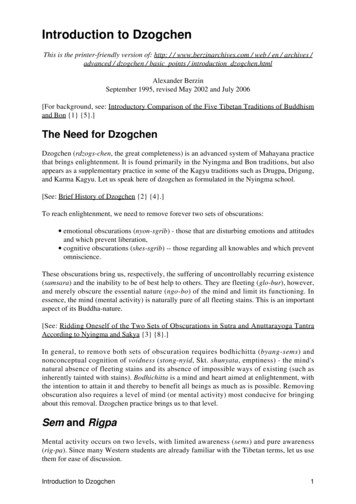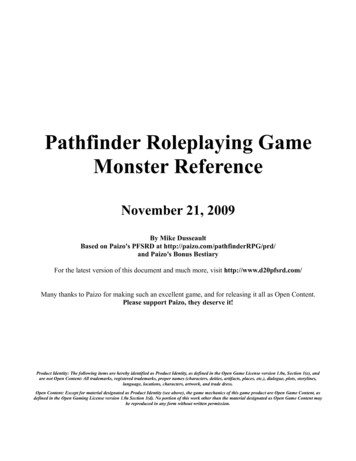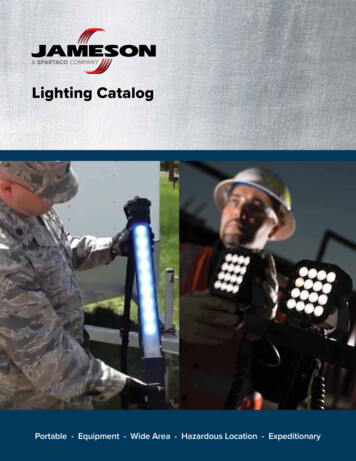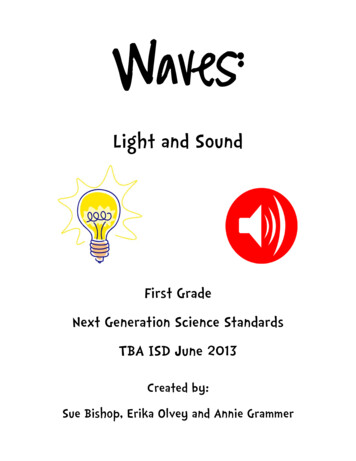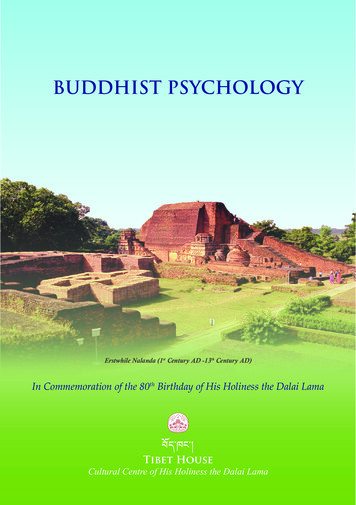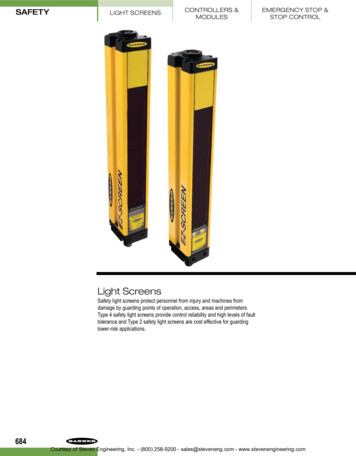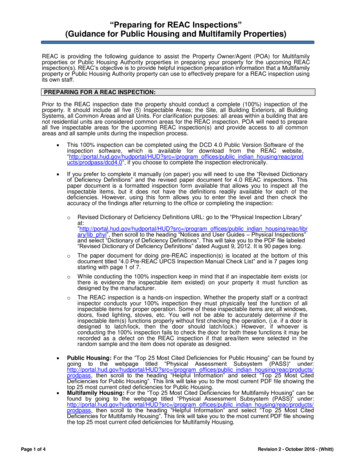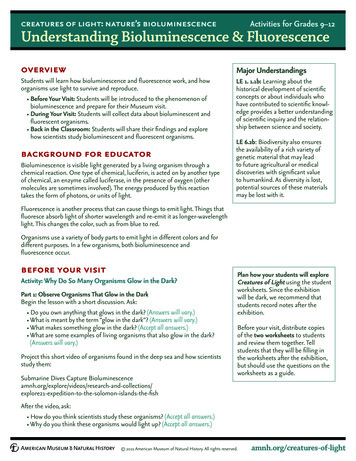
Transcription
creatures of light: nature’s bioluminescenceActivities for Grades 9–12Understanding Bioluminescence & FluorescenceoverviewMajor UnderstandingsStudents will learn how bioluminescence and fluorescence work, and howorganisms use light to survive and reproduce. B efore Your Visit: Students will be introduced to the phenomenon ofbioluminescence and prepare for their Museum visit. D uring Your Visit: Students will collect data about bioluminescent andfluorescent organisms. B ack in the Classroom: Students will share their findings and explorehow scientists study bioluminescent and fluorescent organisms.LE 1. 1.1b: Learning about thehistorical development of scientificconcepts or about individuals whohave contributed to scientific knowledge provides a better understandingof scientific inquiry and the relationship between science and society.background for educatorBioluminescence is visible light generated by a living organism through achemical reaction. One type of chemical, luciferin, is acted on by another typeof chemical, an enzyme called luciferase, in the presence of oxygen (othermolecules are sometimes involved). The energy produced by this reactiontakes the form of photons, or units of light.LE 6.2b: Biodiversity also ensuresthe availability of a rich variety ofgenetic material that may leadto future agricultural or medicaldiscoveries with significant valueto humankind. As diversity is lost,potential sources of these materialsmay be lost with it.Fluorescence is another process that can cause things to emit light. Things thatfluoresce absorb light of shorter wavelength and re-emit it as longer-wavelengthlight. This changes the color, such as from blue to red.Organisms use a variety of body parts to emit light in different colors and fordifferent purposes. In a few organisms, both bioluminescence andfluorescence occur.before your visitActivity: Why Do So Many Organisms Glow in the Dark?Part 1: Observe Organisms That Glow in the DarkBegin the lesson with a short discussion. Ask: D o you own anything that glows in the dark? (Answers will vary.) What is meant by the term “glow in the dark”? (Answers will vary.) What makes something glow in the dark? (Accept all answers.) What are some examples of living organisms that also glow in the dark?(Answers will vary.)Project this short video of organisms found in the deep sea and how scientistsstudy them:Submarine Dives Capture islands-the-fishPlan how your students will exploreCreatures of Light using the studentworksheets. Since the exhibitionwill be dark, we recommend thatstudents record notes after theexhibition.Before your visit, distribute copiesof the two worksheets to studentsand review them together. Tellstudents that they will be filling inthe worksheets after the exhibition,but should use the questions on theworksheets as a guide.After the video, ask: H ow do you think scientists study these organisms? (Accept all answers.) Why do you think these organisms would light up? (Accept all answers.) 2021 American Museum of Natural History. All rights reserved.amnh.org/creatures-of-light
creatures of light: nature’s bioluminescenceActivities for Grades 9–12Part 2: Prepare for Your Museum VisitDivide your class into groups of two or three. Distribute the “Preparing for Creatures of Light” worksheet to each student.(You can also project the Creatures of Light exhibition map.)Tell students that the goal of the visit is to observe these organisms and learn how and why they light up. Ask each groupto pick two or three sections to explore in the exhibition and come up with their own questions. Tell students the space willbe too dark to take notes. Review the guiding activities in advance.Optional Activity: Demonstrating Fluorescence of ChlorophyllUse this classroom experiment to introduce students to the concept of fluorescence. See the full activity at the end of thisPDF.during your visitCreatures of Light: Nature’s Bioluminescence3rd floor (45 minutes)Review the second part of the “Preparing for Creatures of Light” worksheet with students. Encourage them to use all theirsenses to explore what life in darkness might be like. Have them use the worksheet to guide their observations in theexhibition. Tell them that they will regroup in the Milstein Hall of Ocean Life to record their observations.Milstein Hall of Ocean Life1st floor (30 minutes)This hall provides a great opportunity to reinforce key ideas of the Creatures of Light exhibition as well as provide a spacefor students to sit and record notes about what they learned.back in the classroomActivity: Exhibition Wrap UpHave students gather in small groups to share their notes from the visit about how and why so many organisms in theopen ocean produce light.Then as a class, have students make a list of ways we benefit from the biodiversity of the ocean. Ask: How many of theorganisms in the exhibition do you think we benefit from? (Accept all answers.)Activity: How do scientists study bioluminescence and fluorescence?Working in small groups, have students read one of the scientist profiles (Edith Widder or Osamu Shimomura; see theend of this PDF). Then have them use the following questions to guide their reflections, and share their thoughts with therest of the class.Reflection Questions1. What skills do you need to do this type of research?2. What tools do you think scientists use in this kind of research? Why?3. What is the best vehicle for observing deep-sea life? Why?4. Describe the benefits to society of studying bioluminescence and fluorescence.5. Would you be interested in working with the scientist you read about? Why or why not?6. Defend this statement, using evidence gathered on your trip to the Museum: It is important to protect the biodiversityof bioluminescent and fluorescent organisms. 2021 American Museum of Natural History. All rights reserved.amnh.org/creatures-of-light
creatures of light: nature’s bioluminescenceActivities for Grades 9–12online resourcesScience Bulletins: Jellies Down epIncreasingly, marine researchers are finding that there are far more jellies and jellyfish in the world’s oceans thanpreviously believed. These creatures may play an unexpectedly large role in ocean ecosystems. This documentary, whichwas produced by the Museum’s innovative multimedia program Science Bulletins, follows scientists at the Monterey BayAquarium Research Institute as they retrieve jellies from the deep and features spectacular underwater footage.Illuminating the Perils of Pollution, Nature’s ral Light Photo Slideshow: lEdith Widder: Glowing Life in an Underwater World: youtube.com/watch?v IThAD5yKrgE 2021 American Museum of Natural History. All rights reserved.amnh.org/creatures-of-light
creatures of light: nature’s bioluminescenceGrades 9–12Student Worksheet: Preparing for the ExhibitionWorking with your team, pick three sections of the exhibition to investigate the question: Why do so manyorganisms produce light? exitWhy did you pick these sections?54What questions do you have?32in the exhibitionAlthough you can take notes in the exhibition, it will bechallenging in the low light. So use all your senses toexperience what life is like in the absence of light, and usethe following activities to guide your observations.Investigate two or three organisms from your sectionsthat use bioluminescence or fluorescence.1Read and engage with iPads to learn more about howbioluminescence and fluorescence work.Observe what part of the organism produces light.Reflect with your team on how the process of emittinglight might benefit the organism.sections:1. A Summer’s Night: Fireflies1. A Mysterious Cave: Glowworms3. A Sparkling Sea: Dinoflagellates4. S ea Shores: Corals, Jellies, & Fishes5. T he Deep Ocean: Predators & Prey enterWatch the Deep Ocean video.Think about what it must be like to work in thedeep ocean. 2021 American Museum of Natural History. All rights reserved.amnh.org/creatures-of-light
creatures of light: nature’s bioluminescenceStudent Worksheet: At the MuseumGrades 9–121. C reatures of Light exhibitionRecord information about three organisms that you observed in the exhibition.Name ofOrganismWhat part of the organism lights up?Does it use bioluminescence, fluorescence,or both?What is bioluminescence?How might bioluminescence benefit organisms?Where would you want to visit and why?2. M ilstein Hall of Ocean Life: Deep Sea EcosystemObserve the diorama and describe what you see.Sketch an organism and label the parts that light up.Working with your team, find five differentorganisms that use light.Name ofOrganismWhat part of the organism lights up?Does it use bioluminescence, fluorescence,or both? 2021 American Museum of Natural History. All rights reserved.amnh.org/creatures-of-light
activityDemonstrating Fluorescence of ChlorophyllUse this classroom experiment to introduce students to the concept of fluorescence.Materials per Group: flashlight 100 g spinach ethanol coffee filter two 250 ml beakersPut students in groups of three to four. Alternatively, you can also demonstrate this for the class.1. Chop about 100 grams of spinach leaves into small pieces, and put into 250 ml beaker with 75 ml of ethanol.2. Let the jar stand for 20 minutes.3. Then pour through a coffee filter into a clean clear beaker.4. Shine a flashlight on one side of the jar, and observe. Ask students to record their observations. (Studentsshould observe a dark red fluorescence.)5. Tell students that the red color is a result of fluorescence, and that they’ll learn more about fluorescence inthe exhibition.Background for Educators and Students: Fluorescence is one way some organisms light up. In fluorescence, electrons of certain type of molecules become excited when they absorb high-energy lightfrom an outside source. As the electrons calm down, the energy absorbed is released as lower-energy light.Since light fuels fluorescence, the glow is more intense when they are under high-energy radiation, likeultraviolet light. One of the most common fluorescent molecules in nature is chlorophyll, the green pigment found in plants.Leaves are green when lit by the Sun because they reflect the green light wavelengths. Chlrophyll absorbsmostly blue and red light wavelengths, which are the driving energy of photosynthesis. The energy of light ismeasured as wavelength: the shorter the wavelength, the stronger the energy of the light. When illuminatedby ultraviolet light, the plant pigment glows red, which is lower in energy. The missing energy or difference inenergy between the high-energy of the UV light and the lower-energy red light is released as heat energy Aless intense fluorescence can be produced using a flashlight. In nature, plants fluoresce with daylight but thisphenomenon can be seen only with special instruments. 2021 American Museum of Natural History. All rights reserved.amnh.org
scientist profileEdith WidderBioluminescence AdvocateIn 1984, as she was testing a new diving suit, marine biologist EdithWidder descended 880 feet (268 meters) into the ocean and wasoverwhelmed: A display of blue bioluminescent light burst forth beforeher. Thus began her obsession with creatures of light!Filming in the DeepSo that others could appreciate the amazing varietyof sea life, Widder beganshooting videos from insidea submersible. Because thevehicle’s noise and brightlights tended to scare awaycreatures, she developeda less obtrusive device.An Eye in the SeaThis device, called “Eye-in-the-Sea,” sits on the bottom of the ocean and sends images to the surface. It includesa camera that uses red light, invisible to most sea creatures. And it incorporates an epoxy “jellyfish” withprogrammable blue lights, seen here, to attract animals.SuccessThe device’s first foray in the Gulf of Mexico in 2004 was a triumph,capturing on film a previously unknown squid species. In a venture3,000 feet (914 meters) down to the floor of the underwater MontereyCanyon off California’s coast, a more advanced camera recorded manymore species. The explorations continue.A New EffortWidder is working on a method to estimate pollution levels: She addsbioluminescent bacteria to lagoon sediment and measures how fastthe bacteria’s light diminishes. 2021 American Museum of Natural History. All rights reserved.amnh.org
scientist profileOsamu ShimomuraIn 2008, scientist Osamu Shimomura won a Nobel Prize in Chemistry fordiscovering green fluorescent protein (GFP). But he hadn’t actually beenlooking for GFP. He had been trying to purify the bioluminescent components of the jellyfish Aequorea victoria.No Light?In the early sixties, intrigued by the jellyfish’s green luminescence, Shimomura managed to prepare a solution with the luminescent tissues of 10,000jellyfish! He realized that the light wasn’t produced by a typical luciferase/luciferine reaction but probably by a special protein. He tried many timesbut - unlike other bioluminescent reactions he knew – the solution did notlight up outside the jellyfish. What was missing?Strong Light!By chance, he added a small amount of seawater to the solution, and wasrewarded with what he called an “explosively strong” light! He realized thatfor the jellyfish’s bioluminescence to work, it needed calcium ions from theseawater. He purified the luminescent protein and called it aequorin.Green, Not BlueStrangely, in the lab, the bioluminescent light was blue, not green as in thejellyfish. Upon examination, Shimomura found an additional molecule,Green Fluorescent Protein. The GFP absorbed the blue bioluminescent lightproduced by the aequorin and emitted it as lower-energy green light andthe puzzle was solved!A Major ContributionShimomura’s discovery, GFP, has been adapted by other scientists to becomea vital tool in biological research.Colorful Tool KitNaturally occurring fluorescent proteins have become important tools for researchers as they investigatequestions like how stem cells specialize or how brain cells communicate. GFP—green fluorescent protein—wasthe first to be adapted for broad scientific use. Then, red fluorescent proteins from corals were adapted. Nowfluorescent proteins of many colors can be expressed in living cells, where they literally illuminate biologicalprocesses. 2021 American Museum of Natural History. All rights reserved.amnh.org
creatures of light: nature’s bioluminescence Activities for Grades 9–12 Major Understandings LE 1. 1.1b: Learning about the historical development of scientific concepts or about individuals who have contributed to scientific knowl-edge provides a better understanding of scientific inquiry and the re


